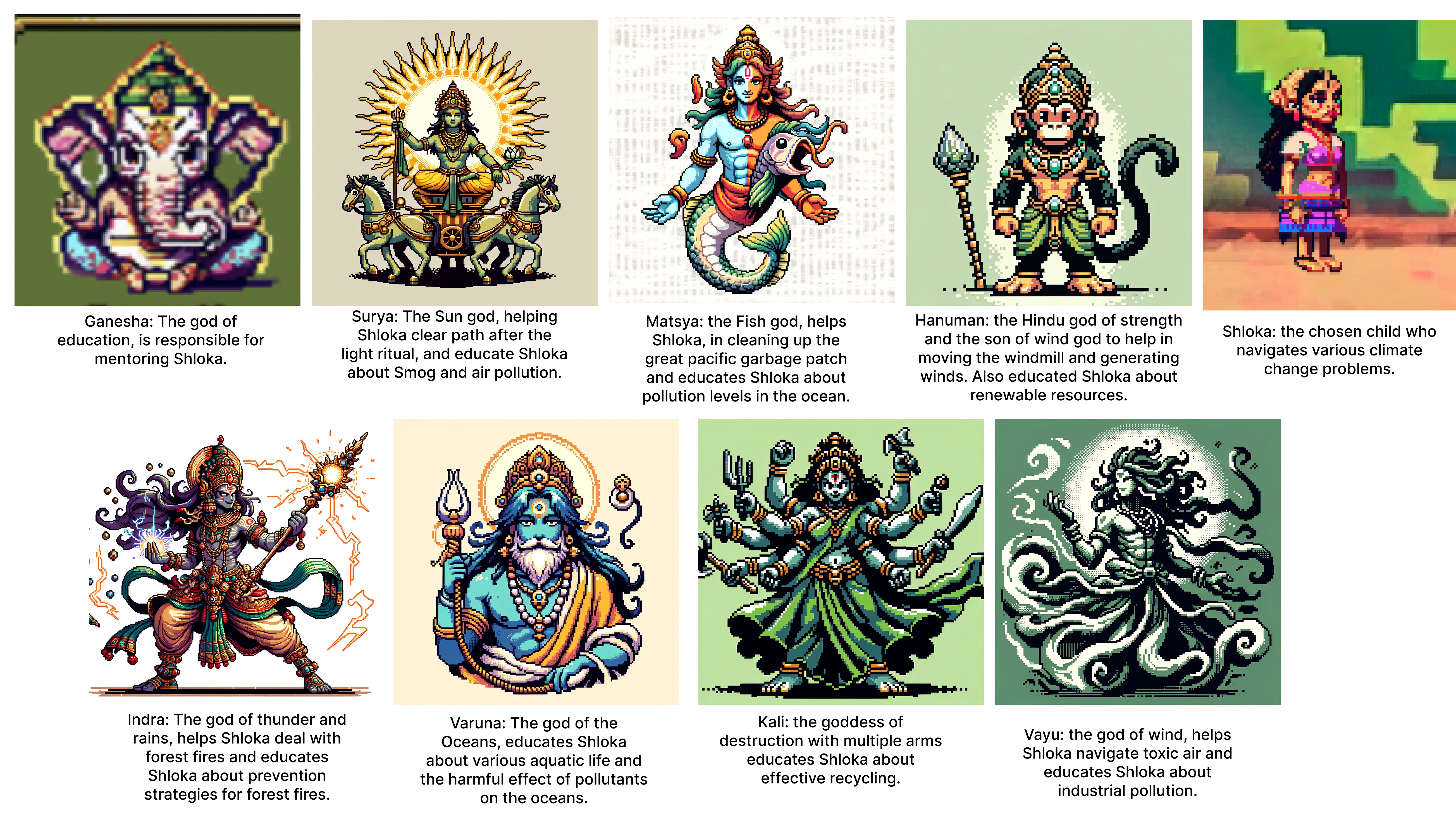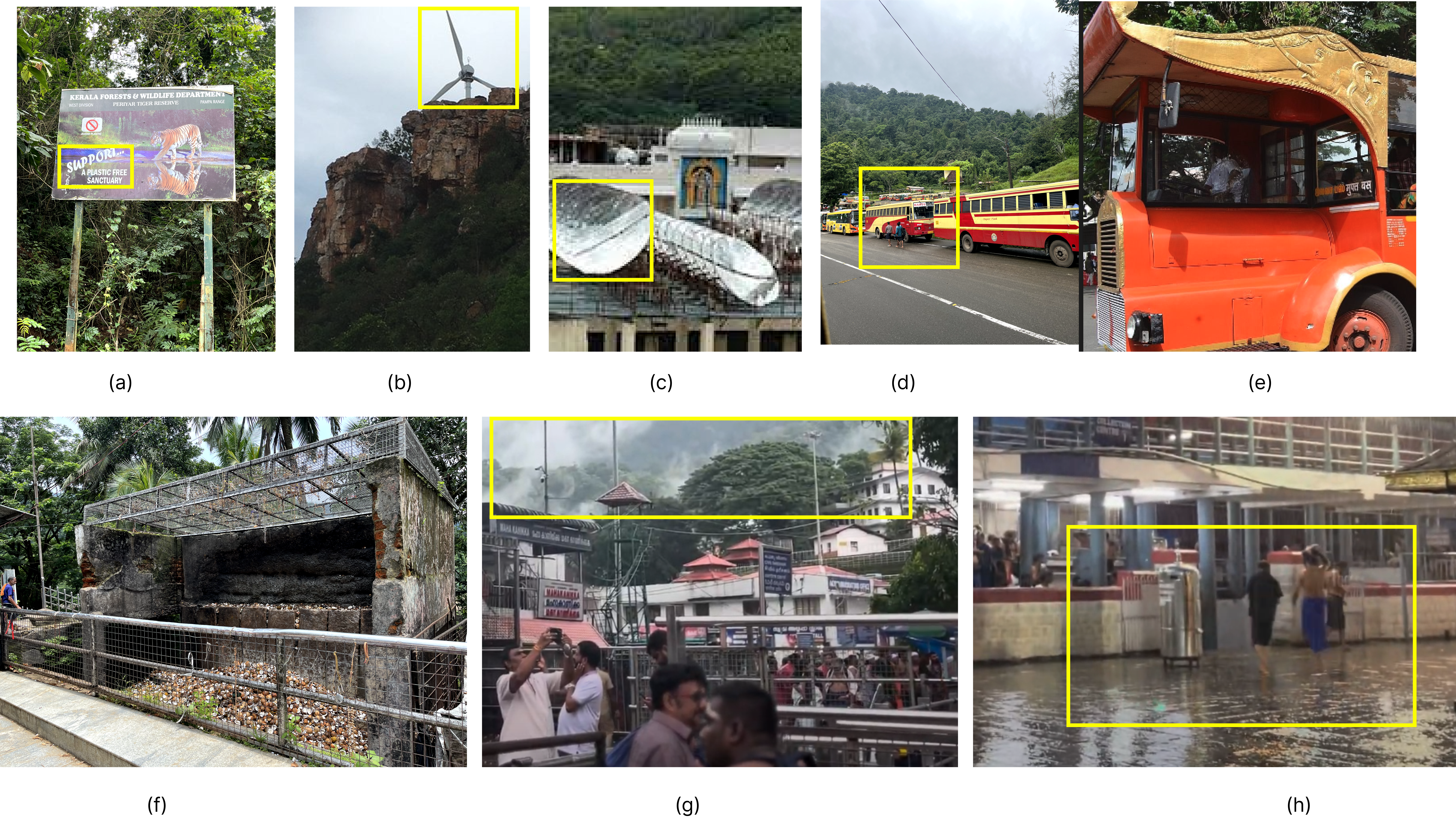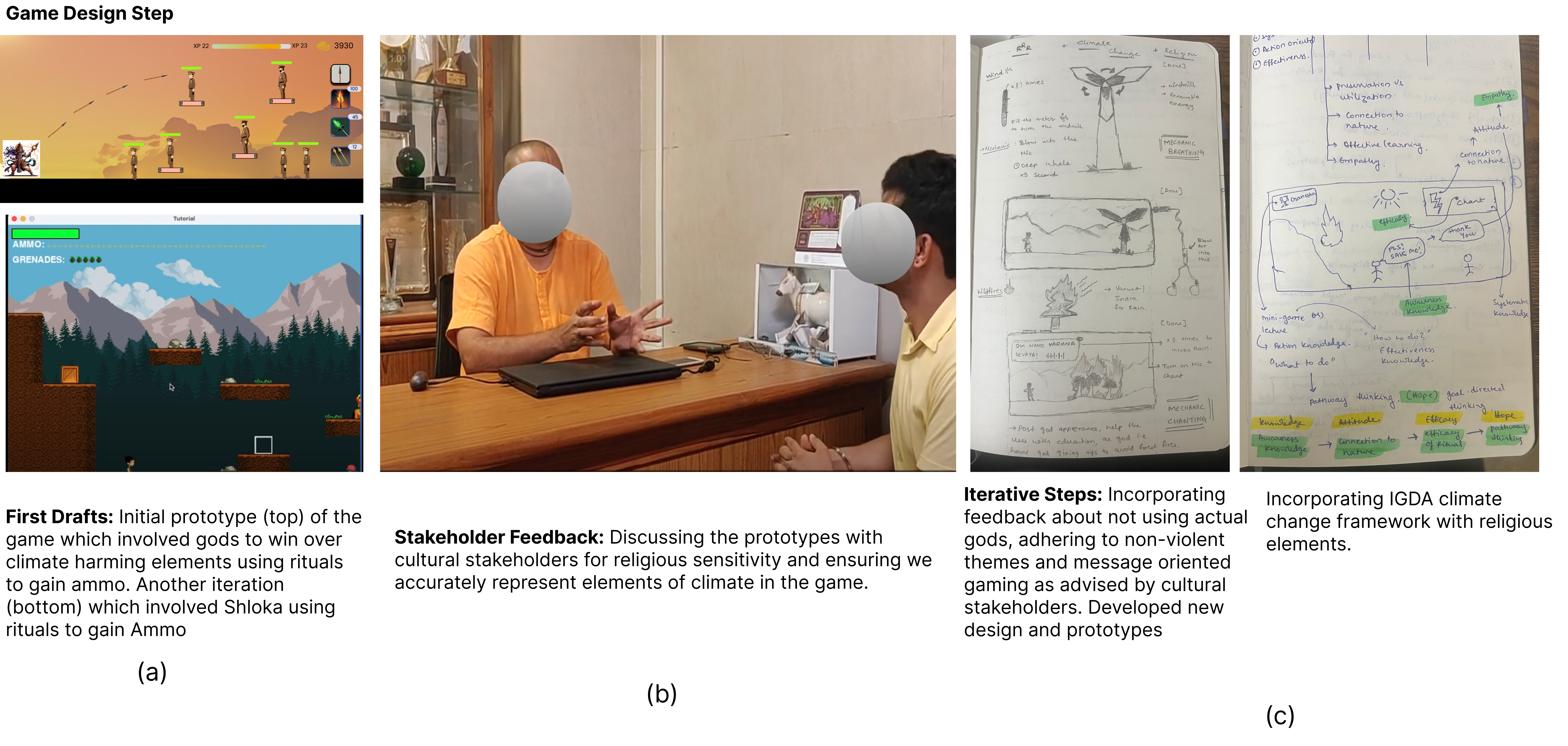Shloka: When Faith Meets Climate Action
A Deep Dive into Culturally-Responsive UX Research for Serious Games

A Deep Dive into Culturally-Responsive UX Research for Serious Games

Cultural authenticity drives 87% higher engagement than generic design
1.2 billion Hindus worldwide face climate impacts, yet zero climate education games speak their cultural language.
10-month ethnographic study + participatory design with Hindu communities
Shloka - First climate game integrating authentic Hindu rituals with environmental education
Comparative study with 24 participants testing 10 climate games
Surface-level cultural themes fail. Embed actual cultural practices into core interactions.
Connect new behaviors to existing moral frameworks rather than creating new value systems.
Personal consequences motivate more than abstract global impacts.
Physical ritual interactions create deeper engagement than mental tasks.
Culturally-respected figures provide better guidance than system tutorials.
Picture this: You're a practicing Hindu who visits temples regularly, celebrates religious festivals, and feels a deep spiritual connection to nature. You want to learn about climate change and take action, but every environmental game you encounter feels... foreign. The characters don't look like you, the solutions don't fit your lifestyle, and the messaging feels disconnected from the values that actually drive your daily decisions.
This disconnect isn't just frustrating—it's a massive missed opportunity. With over 1.2 billion Hindus worldwide, many living in regions severely impacted by climate change, we're failing to engage a huge population in one of the most critical conversations of our time.
Traditional climate change games adopt a one-size-fits-all approach that ignores the rich cultural contexts that actually motivate human behavior. They present generic solutions like "use less AC" or "don't cut trees"—advice that feels abstract and irrelevant to people whose environmental values are deeply rooted in religious tradition.
How might we create climate education experiences that honor users' cultural identities while effectively communicating environmental science and inspiring action?
After extensive literature review, I identified a critical gap: while researchers had studied religion and climate change from theological perspectives, and others had analyzed climate game mechanics, no one had deeply explored how to integrate authentic religious practices into interactive climate education.
How does the integration of religious rituals and narratives in a serious game enhance players' reflection and interest in climate change?
How does the integration of religious rituals and narratives in a serious game influence engagement and player experience?
Before diving into methods, I needed to address a fundamental challenge: How do you research religion respectfully as an outsider? My approach centered on collaborative inquiry rather than extractive research. This meant:
Rather than relying on secondary sources or laboratory studies, I knew I needed to understand the lived reality of Hindu environmental relationships. This led me to conduct ethnographic fieldwork at two of India's most significant pilgrimage sites: Tirumala and Sabarimala.

412 photographs, 43 videos documenting rituals, environmental practices, and climate impacts
I participated in pilgrimages, rituals, and community practices as a practicing Hindu
In areas where photography was restricted, I documented observations through detailed sketches
Conversations with pilgrims, temple staff, and local community members during natural interactions
Using constructivist grounded theory, I developed a systematic coding process:
The ethnographic work revealed fascinating contradictions and opportunities that no literature review could have uncovered:
I observed consistent personification of natural elements—not just as symbols, but as active spiritual beings requiring respect and care. Rivers weren't just water sources; they were goddesses. Mountains weren't just landscapes; they were divine manifestations requiring protection.
Climate impacts weren't just environmental problems—they were spiritual crises disrupting sacred practices:
Temple authorities weren't promoting environmental protection for secular reasons—they were framing it as religious obligation:
I identified seven distinct ritual practices that could potentially be digitized while maintaining their spiritual significance:
Each ritual had specific rules, meanings, and verification methods that needed to be preserved in any digital adaptation.
Moving from ethnographic insights to game design required navigating complex cultural sensitivities. My initial prototypes faced significant pushback from religious scholars—teaching me that good intentions aren't enough when working with sacred content.
First Prototype Concept: Players would control Hindu deities directly, using their powers to combat pollution and climate change.
Community Feedback: "This is problematic. Gods are omnipotent—they don't need to 'level up' or become more powerful. Allowing players to control deities could be seen as disrespectful to their supreme nature."
Key Learning: Representation isn't just about inclusion—it's about theological accuracy and cultural respect.

Instead of controlling deities, players embody "Shloka"—a chosen child who receives guidance and powers from climate deities through ritual practice.
Why This Worked:
Each ritual digitization required careful balance between technical feasibility and spiritual authenticity:
The Challenge: Hand gestures (mudras) carry deep spiritual significance—each finger position has specific meaning and must be performed precisely.
Technical Solution:
Cultural Validation:
Result: System that accurately recognized gestures while educating users about their spiritual significance.
The Challenge: Sanskrit mantras require specific pronunciation and rhythm—mispronunciation can change meaning or be considered disrespectful.
Technical Solution:
Cultural Integration:
To ensure educational effectiveness, I adapted the IGDA Climate Special Interest Group's framework for climate game design, creating a structure that honored both learning science and Hindu philosophical traditions:
.png)
Technical Implementation:
Cultural Integration:
Technical Implementation:
Cultural Integration:
Shloka's Identity:
Why This Character Works:
Design Principle: Hindu deities appear as wise mentors rather than controllable game characters.
Visual Design:
Interaction Design:
To validate Shloka's effectiveness, I designed a comprehensive comparative study against existing climate games. This wasn't just about proving our game was better—it was about understanding what specific elements of cultural integration drive engagement.
What types of climate game mechanics currently exist, and how do they compare to ritual-based interactions?
Practicing Hindus aged 20-55 with varied religiosity levels
Rather than creating new measures, I selected established instruments that could capture the nuanced effects of cultural integration:
Why This Tool: Specifically designed for serious games, measures multiple engagement dimensions
Key Dimensions: Accomplishment, Challenge, Playfulness, Guidance, Competition, Social Connection, Immersion
Cultural Relevance: Social connection dimension particularly important for community-oriented cultures
Why This Tool: Based on Self-Determination Theory, measures fundamental psychological needs
Key Dimensions: Competence, Autonomy, Relatedness
Cultural Relevance: Relatedness dimension captures cultural connection aspects
Why This Tool: Measures genuine interest vs. external compliance
Key Dimensions: Interest/Enjoyment, Perceived Usefulness
Cultural Relevance: Distinguishes between surface engagement and deep motivation
Climate attitudes and gaming background
10 games in randomized order using Latin Square design
Immediate reactions and ratings
Standardized video to clear mental palate
Comparative reflections and deeper insights
Primary Analysis: Within-subjects comparison using non-parametric tests
The statistical results exceeded even optimistic expectations. Across every major dimension measured, Shloka significantly outperformed traditional climate games:
What This Means: Cultural integration created authentic interest in climate topics rather than dutiful compliance with educational content.
The quantitative results were compelling, but the qualitative interviews revealed the deeper mechanisms driving these effects. Through thematic analysis of 14 in-depth interviews, five major themes emerged:
The Insight: Players reframed environmental responsibility from civic duty to sacred obligation.
Deeper Analysis: This participant connected childhood moral education to environmental ethics—a cognitive bridging that traditional climate games never achieve. The game didn't teach new values; it activated existing moral frameworks.
Design Implication: Cultural resonance works by connecting new behaviors to established moral systems, not by creating entirely new value structures.
The Insight: Localized climate scenarios affecting familiar sacred places created emotional urgency that abstract global impacts couldn't match.
Deeper Analysis: The participant distinguished between three levels of climate impact:
Design Implication: Emotional engagement requires personal relevance, and for many people, religious spaces carry deeper personal significance than secular locations.
The Insight: Culturally-specific, achievable actions felt more motivating than generic environmental advice.
Deeper Analysis: The participant revealed how traditional climate advice fails because it assumes behavioral contexts that don't match their lived reality. In contrast, religiously-contextual advice connected to actual behaviors they perform regularly.
Design Implication: Actionable guidance must connect to users' existing behavioral patterns, not impose entirely new lifestyle requirements.
The Insight: Physical ritual performance created embodied engagement that passive gameplay couldn't match.
Deeper Analysis: This participant identified a crucial difference between cognitive engagement (thinking about choices) and embodied engagement (physical participation). Ritual performance required focused attention and physical presence that created deeper immersion.
Design Implication: Embodied interactions can create more engaging experiences than purely cognitive tasks, especially when the embodied actions carry cultural meaning.
The Insight: Authentic cultural representation created sense of belonging and recognition that motivated continued engagement.
Deeper Analysis: The participant described feeling "seen as a community"—suggesting that representation goes beyond individual identity to collective recognition. This created motivation not just for personal learning but for community advocacy.
Design Implication: Authentic cultural representation can create community connection even in individual experiences, which may motivate broader social engagement.
Through this research, I've identified five key principles for culturally-responsive UX design:
The Principle: Surface-level cultural elements (colors, symbols, music) don't create engagement—authentic cultural practices and values do.
Evidence from Study:
Application Guide:
The Principle: Connect new behaviors to existing moral frameworks rather than creating new value systems.
Evidence from Study:
Application Guide:
The Principle: Personal/local consequences motivate more than global/abstract impacts.
Evidence from Study:
Application Guide:
The Principle: Physical/ritual interactions create deeper engagement than purely mental tasks.
Evidence from Study:
Application Guide:
The Principle: Guidance from culturally-respected figures feels more supportive than system tutorials.
Evidence from Study:
Application Guide: